 A call to action, or CTA, tells the reader on your website what you want them to do. CTA buttons are buttons that the reader can click that will direct them towards your conversion goal, whether it is a purchase or a subscription or something else.
A call to action, or CTA, tells the reader on your website what you want them to do. CTA buttons are buttons that the reader can click that will direct them towards your conversion goal, whether it is a purchase or a subscription or something else.
CTA buttons may seem like a simple part of your website, but in reality they must be strategically designed to work well. The key to creating and effectively using a CTA button is optimizing it through A/B testing.
With solid testing and implementation, your CTA button can increase your conversion rates and help you meet your goal. Here are some tips to help you create strong CTA buttons.
Make Them Noticeable
CTA buttons need to stand out against the background of the web page. This means they need contrasting color oreven a 3-dimensional look so people’s eyes are naturally drawn to them. If they blend in to the background, they may be missed by visitors.
They Need to Feel Familiar
The CTA button should have a familiar shape. Either rounded edges or square edges work well, but you will want to initially model the button after others to ensure people know what it is and what it’s for. You can later change shapes as you engage in testing.
Use Action Text
Make sure the CTA button tells the reader what to do. Use action words that will direct the action you want. Whoever, never say “click here.” Instead, be specific. Think about what you want the reader to do, then use that verbiage.
One way to think about CTA copy is that the text should finish the sentence “I want to…” For example, CTAs could be:
- Read more
- Subscribe now
- Buy now
- Try a free trial
- Download now
These are examples of effective, action text that works to convert.
Repeat the CTA
If you’re making a landing page, don’t limit yourself to one CTA button. Add several in many pages on the website, so the user will have multiple chances to click the CTA.
Fulfill Expectations
Your CTA button and its language gives the reader an expectation of what will happen when they click. If the CTA says “buy now,” they expect to go to a shopping cart with the item inside. If that’s not what happens when they click, they are likely going to click away from your site, so make sure the words on the button coincide with the page it takes them to.
Emphasize Benefits
When possible, your CTA button should demonstrate a benefit or your value proposition. For instance, “Download Free Report” shows the reader what they will do and emphasizes that the report is free.
Don’t Rely on “Studies”
You’ll find many articles online that say certain colors, sizes, or shapes of buttons work best. These may or may not be true, but the reality is they are not specific to your target audience. The best way to determine what works for your audience is to practice A/B testing.
A/B testing sets up two different examples, then runs them both to determine which performs better. With A/B testing, you set up a scenario where you randomly show one of two options to your site visitors, then run analytics to see which one gives you the greater click-through and conversion rate.
With A/B testing, you can test just about anything relating to your CTA buttons. You may test its color, placement on the page, number of buttons on the page, overall size and shape, or the copy on the button.A/B testing is not a one-time process. You will continually perform A/B testing and tweak your CTA buttons for better conversion rates.
If you need to create a CTA, then your website has some kind of conversion goals. It may be to get a visitor to sign up for a newsletter, watch a webinar, or buy furniture. If no one notices your Call-to-Action button, then your conversion rate will be zero. Increasing traffic is always good, but those efforts are worthless if none of the traffic converts.
The above suggestions will give you a good starting place for creating a button that contrasts with the background and draws readers in with copy that emphasizes benefits. By A/B testing colors, shapes, placements, and copy, you can single-handedly raise the conversion rates for any page on your website.

